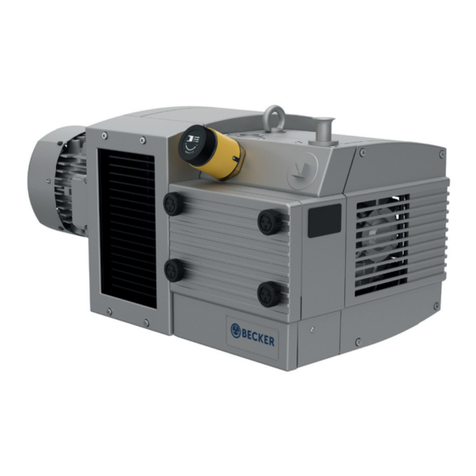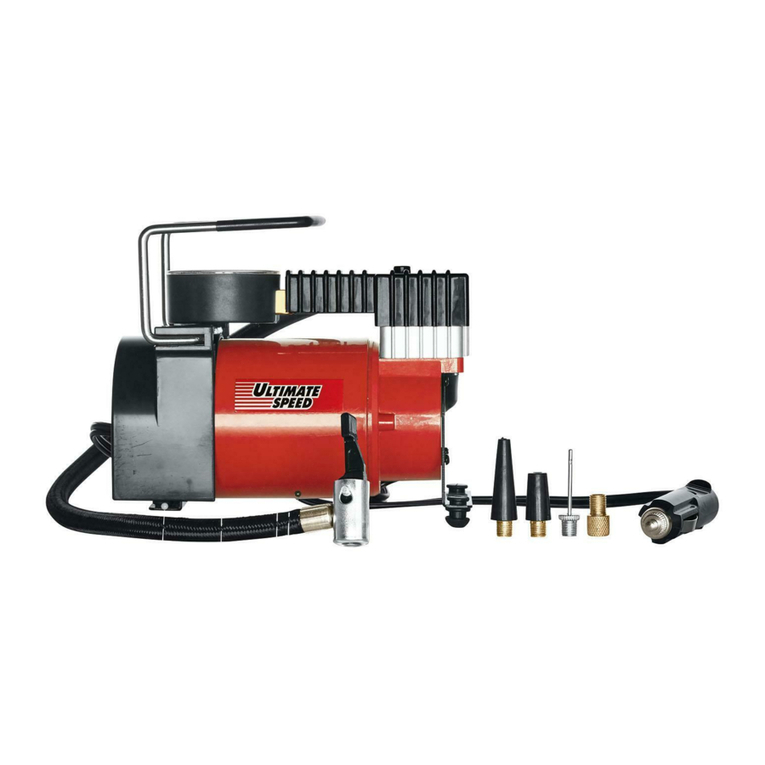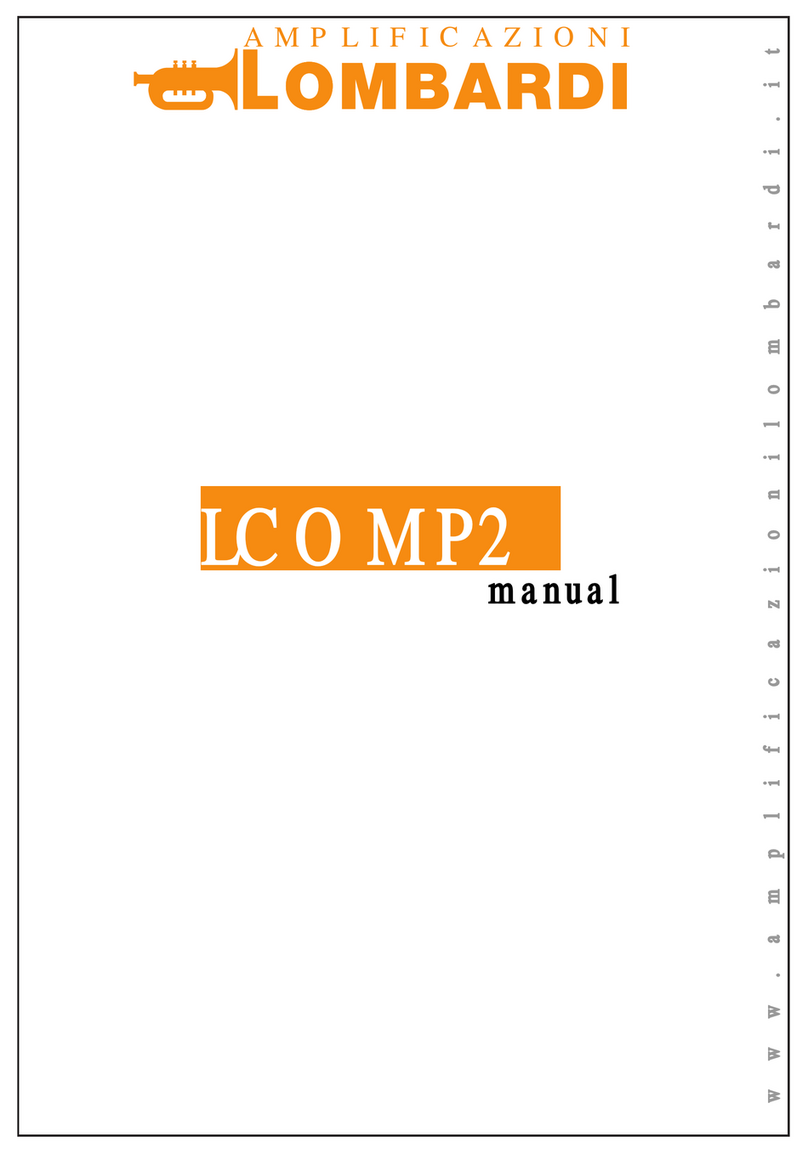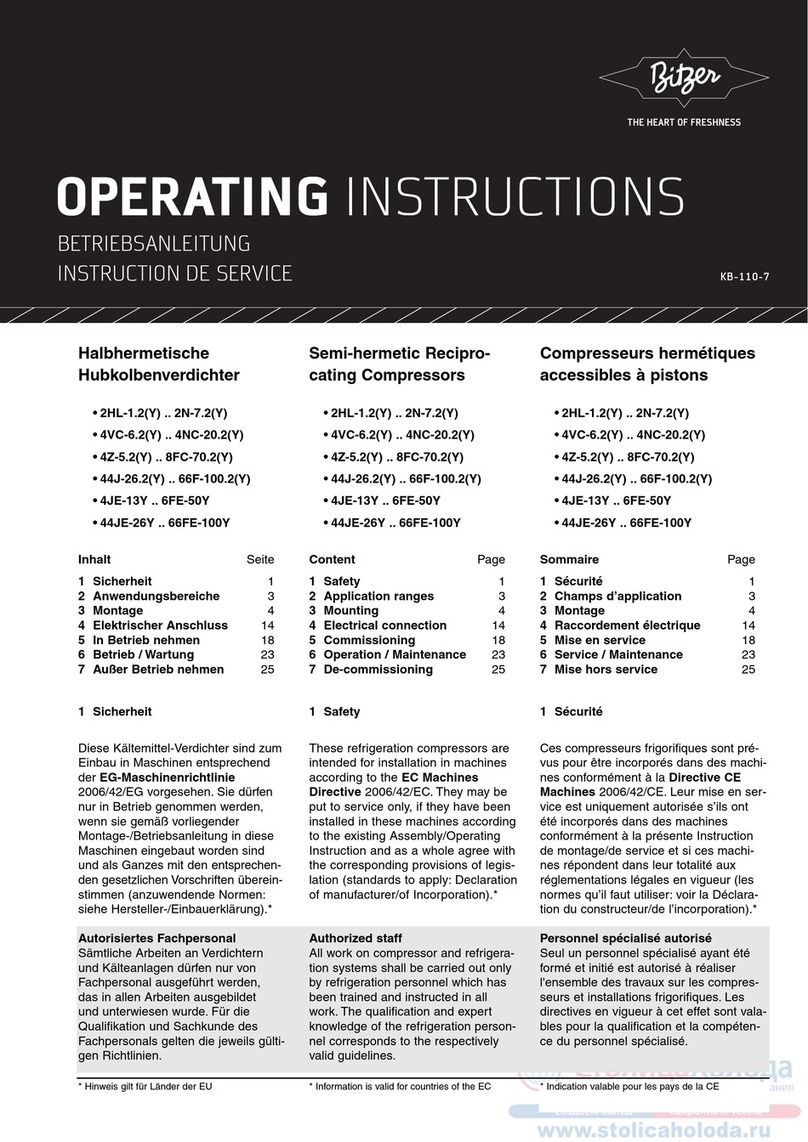RIX Industries RIX 2V3B-4.1V Series Use and care manual

4900 Industrial Way Benicia, CA 94510 USA Phone 707-747-5900 Fax 707-747-9200
Parts Fax 707-758-0398
OPERATING INSTRUCTIONS
and PARTS LIST for
RIX INDUSTRIES
DRY OXYGEN COMPRESSOR
MODEL 2V3B-4.1V
40 PSIG Inlet, 2500 PSIG Discharge
S/N’s 12991 and Above
P/N: MAN-2V3B-4.1V, Rev. (F)

MAN-2V3B-4.1V
Rev (E)
REVISION PAGE
Revision
Date
By Pages
Revised
Brief Description
B 10/01/08 AC 3-4, 7-1, 7-3,
7-5, 7-6, 7-14 REVISED BOM TO AS-BUILT; UPDATED
DRAWINGS TO REFLECT BOM CHANGE
C
9/18/09
SS
iii
PG. 2
PG. 4
iv, PG. 5
PG. 6
PG. 10
PG. 11, PG. 12
PG. 33
A7458
A3485-5-9
ADDED DRAWING A11151
CHANGED “SHOULD” TO “MUST” FOR
COMPRESSOR MOUNTING
ADDED REFERNCE TO CHECKING
THAT OIL WAS ¾ UP SIGHT GLASS
CHANGED OPERATING RANGE TO 30-40
PSIG
CORRECTED SUCTION PRESSURE
SWITCH SETTINGS AND HIGH GAS
TEMP LIMITS
CHANGED VALVE SERVICE INTERVAL
TO 4500 HRS.
REMOVED REFERENCE TO 2V3 IN
TITLE
ADDED PRESSURE SETTING TO #203
CORRECTED pn FOR # 222
NOW REV B
REDRAWN
B10791 ADDED DETAIL OF FRONT COVER OF
ELECTRICAL PANEL
D 12/1/09 SS iii New drawing numbers for Valve assys. New
rev for Electrical Schematic. Added pressure
callout suffixes to pressure switches.
iv Added max allowable ambient temp
allowance. Removed reference to voltage
requirements page.
2
Changed oil capacity to 1 ¾ quarts. Added
note about changing oil annually.
6 Changed shutdown setting on inlet pressure
switch to 30 psi.
8 Changed oil fill level to ¾ way up. Added
note about checking for oil discoloration.

MAN-2V3B-4.1V
Rev (E)
Revision
Date
By Pages
Revised
Brief Description
D (con’t)
9
Changed oil change interval to include
annually.
13 Added d. regarding retensioning of belts.
15
16
26
33
B10979
Removed note about third stage valve stop.
Removed reference to 2 ¼ air cooled cylinder.
Added illustrations showing proper dipper
orientation.
Changed shutdown pressure for inlet pressure
switch. Remove reference to user cleaning
RTD.
New rev. Correct P/N’s and descriptions for
pressure switch set points
E
12/6/10 SS iii
iv
2
6
9
10-11
25
Changed electrical schematic to B12726
Changed panel interior detail to A11376
Temp controller was Fuji is now Eaton, new
dwg # A11346
Added B12570
Deleted note from drive motor regarding
separate page for voltage requirements.
Changed serial # range to 12991 and above.
Changed oil shipped in compressor from SAE
30 to ISO 150 machine oil.
Changed high temperature shutdown from 375
to 400F
Removed reference grease fittings on motor,
bearings are sealed for life. Reinserted section
5.7. This section was accidentally deleted
from the previous version of the manual.
Various changes to text.
Deleted step j. Added warning.

MAN-2V3B-4.1V
Rev (F)
Revision
Date
By Pages
Revised
Brief Description
E (cont’)
F
5/18/11
CJC
34
37
B10979
B12570
A11151
A10401
7
B12570
A11376
B12726
Added part #’s for –P1A & -P1B sheave and
belts. Deleted 263 & 268. Now part of
electrical panel.
New Bom for Electrical Panel
Replaced with B12726
New Elec Wiring Diagram
Replaced with new drawing A11376
Replaced with new drawing A11346
Changed description of function of machine
when resetting from a high temperature
machine.
Updated drawing to show new jumper wire to
prevent the compressor from automatically
restarting after a high temperature shutdown.
Photo of interior updated to show jumper
included.
Updated drawing to show new jumper wire.

TABLE OF CONTENTS
2V3B-4.1V
P/N: MAN-2V3B-4.1 Rev. (A) i
Title Page
Table of Contents.................................................................................................i
Drawing Index .................................................................................................. iii
REGISTRATION PAGE (Compressor Data / Performance Summary) ...........iv
Oxygen Cleaning Requirements.........................................................................v
Safety Precautions..............................................................................................vi
Compressor Warranty.......................................................................................vii
1. COMPRESSOR OVERVIEW
1.1 DESCRIPTION... .............................................................................................1
1.2 GAS COMPRESSION .....................................................................................1
1.3 GAS FLOW......................................................................................................1
1.4 COOLING... .....................................................................................................1
1.5 CRANKCASE LUBRICATION.................................................................1
2. INSTALLATION
2.1 MOUNTING.....................................................................................................2
2.2 PIPING .............................................................................................................2
2.3 CRANKCASE LUBRICATION ...................................................................... 2
2.4 ELECTRICAL CONNECTIONS.....................................................................3
2.5 STORAGE........................................................................................................3
3. START-UP AND OPERATING PROCEDURES
3.1 SYSTEM CHECKOUT....................................................................................4
3.2 START-UP .......................................................................................................4
3.3 NORMAL OPERATING PRESSURE RANGES............................................5
3.4 RELIEF VALVE SETTINGS...........................................................................5
4. CONTROL SYSTEM
4.1 SAFETY SWITCH SETTINGS .......................................................................6
4.2 CONTROL SYSTEM.......................................................................................6
5. ROUTINE INSPECTION and SCHEDULED MAINTENANCE
5.1 ROUTINE INSPECTION.................................................................................8
5.2 SCHEDULED MAINTENANCE ....................................................................9
5.3 FILTER CLEANING .......................................................................................9
5.4 CRANKCASE LUBRICATING OIL...............................................................9
5.5 ELECTRIC MOTOR LUBRICATION............................................................9
5.6 DRIVE BELTS.................................................................................................9
5.7 PRESSURE RELIEF VALVES .......................................................................9
5.8 GAS PIPING LEAK CHECK ........................................................................10
5.9 VALVES.........................................................................................................10
5.10 PISTON RINGS .............................................................................................11
5.11 CYLINDER LINERS .....................................................................................11
5.12 PISTON ROD OIL SEALS............................................................................11

TABLE OF CONTENTS
2V3B-4.1V
P/N: MAN-2V3B-4.1 Rev. (A) ii
6. TROUBLESHOOTING…………………………………………………………………12
7. CORRECTIVE MAINTENANCE –MECHANICAL SYSTEMS
7.1 ALIGNMENT OF DRIVE PULLEYS...........................................................13
7.2 TIGHTENING DRIVE BELTS......................................................................13
SECTION II – REPAIR
7.3 CYLINDER HEADS......................................................................................14
7.4 COMPRESSOR VALVES .............................................................................15
7.4.1 1ST STAGE VALVE .....................................................................................16
7.4.2 2ND STAGE VALVE....................................................................................17
7.4.3 3RD STAGE VALVE ....................................................................................18
7.5 CYLINDERS..................................................................................................19
7.6 PISTON RINGS .............................................................................................19
7.6.1 REPLACE PISTON RINGS, 1st STAGE......................................................19
7.6.2 REPLACE PISTON RINGS, 2nd STAGE.....................................................20
7.6.3 REPLACE PISTON RINGS, 3rd STAGE......................................................21
7.7 PISTON RODS & OIL WIPER SEALS ........................................................22
7.7.1 INSTALL PISTON ROD & OIL SEALS ......................................................22
7.8 PISTON ROD ADJUSTMENT......................................................................23
7.9 CRANKSHAFT SHAFT SEAL .....................................................................24
7.10 GUIDE CYLINDERS.....................................................................................24
7.11 CONNECTING RODS...................................................................................25
7.12 MAIN BEARINGS.........................................................................................26
7.13 CLEARANCES & TOLERANCES ..............................................................27
7.14 WRENCH TORQUE’S ..................................................................................28
COMPRESSOR PARTS LIST .............................................................................................29
CRANKCASE PARTS LIST ................................................................................................32
ACCESSORY PARTS LIST .................................................................................................33
PLUMBING PARTS LIST ....................................................................................................34
ELECTRICAL PARTS LIST................................................................................................37

DRAWING INDEX
MODELS 2V3B-4.1V
P/N: MAN-2V3B-4.1 Rev. (E)iii
Mechanical Drawing No.
1st Stage Valve Assy ................................................................................................................A11192
2nd Stage Valve Assy ...............................................................................................................A11193
3rd Stage Valve Assy................................................................................................................A11195
3rd Stage Piston Assy ...............................................................................................................A11194
Instructions for Installing Spiral Piston Rings on Floating or Removable Pistons....................A3534
Oil Wiper Assembly................................................................................................................... B7668
Cross Section ...........................................................................................................................B10961
Flow Schematic........................................................................................................................B11179
Plumbing Schematic................................................................................................................A10556
General Arrangement...............................................................................................................B10791
O-Ring Installation and Material Information...........................................................................A5089
Crankcase Assy..........................................................................................................................B9131
Connecting Rod Assy (1” pin)...................................................................................................B8156
Electrical
2V3 Electrical Schematic.........................................................................................................B12726
Electrical Panel Interior Details...............................................................................................A11376
2V3 Electrical Box Settings.....................................................................................................B12570
Manufacturer’s Drawing and Technical Information
Relief Valves..............................................................................................................................A5625
High Pressure Switch (X76-714-2500)......................................................................................A8101
Inlet Pressure Switch (X76-713-40) ..........................................................................................A8042
Temperature Switch, Eaton TC24 (76-12579).........................................................................A11346

P/N: MAN-2V3B-4.1 Rev. (E) 4900 Industrial Way
Benicia, CA 94510 USA
(707) 747-5900 (fax -9200)
www.rixindustries.com iv
REGISTRATION PAGE
RIX MODELS 2V3B-4.1V
Serial Numbers 12991 and above
Compressor Design: Three stage, oil-free compression, air-cooled
Cylinder Sizes: 2.25” & 1 3/8” & 5/8” x 3” stroke
Gas to be compressed: Clean dry Oxygen
Operating Pressures: 30-40 psig inlet, 2500 psig discharge, 100°Fmax. Ambient temp
Flow Rate: 10 SCFM (600 SCFH) with 40 PSIG @ 100°F suction
Operating Environment: Indoor or weather protected
Design speed: 540 RPM
Compressor Rotation: Clockwise viewed from flywheel side
Drive Motor: 10 HP (7.5 kW)
Control Circuit Power: 230V
OPERATING PRESSURES (PSIG/BAR)
All units are factory tested at 40 psig suction and 2500 psig discharge. Interstage pressures
should be approximately as follows:
First Second Third
Suction Stage Stage Stage
PSIG 30-40 210 750 2500
BAR(G) 2.1-2.8 14.5 52 172
Note: the flow rate will vary with the suction pressure, temperature and elevation.

v
OXYGEN COMPATIBILITY
REQUIREMENTS
FOR ALL RIX O2 COMPRESSORS
To prevent FIRE, SERIOUS INJURY or DEATH, it is the User’s responsibility
to ensure that all parts used in the oxygen contacting areas of the compressor are
cleaned for oxygen service prior to installation.
All gas piping and storage systems connected to the compressor must be oxygen
clean and constructed of oxygen compatible materials.
No attempt should be made to work on the machine without full knowledge of
oxygen equipment handling procedures and the potential hazards of contamination.
Cleaning should be in accordance with Compressed Gas Association publication
CGA G-4.1, Cleaning Equipment for Oxygen Service. www.cganet.com
Any work to be done on the compressor where the gas stream may be exposed must
be done in accordance with CGA procedures.
RIX factory oxygen cleaned parts are denoted by an “X” prefix at the beginning of
the part number. It is the User’s responsibility to maintain the cleanliness of factory
cleaned parts, and any areas of the compressor gas stream that may be exposed to
contamination during maintenance.
Assembly drawings included in this manual may not have part numbers "X" marked
and therefore should be used for assembly reference only. Refer to the parts lists in
the RIX manual when ordering all parts.
Use only oxygen compatible O-ring grease and either Viton or Teflon O-rings in
gas piping areas.

vi
SAFETY PRECAUTIONS
Safety precautions are necessary for the protection of personnel and equipment. Prior to any
attempt to install, operate, maintain, troubleshoot or repair any part of the compressor, all
warnings and cautions included here and/or appearing throughout this manual should be
thoroughly reviewed and understood.
1. All electrical components associated with this equipment shall be installed and grounded
in accordance with applicable codes and regulations.
2. Special precautionary measures are essential to prevent applying power while repair work
is in progress. In automatic mode, the machine may restart at any time.
3. Before working on electrical equipment, take steps to ensure system is de-energized and
will remain so while work is in progress. All circuits not known to be DEAD must be
considered LIVE and dangerous at all times.
4. Do not make any unauthorized alteration to equipment.
5. Do not touch cylinder heads or discharge gas lines from the heads up to the heat
exchanger inlets. These are hot and can cause serious burns.
6. Do not stick hands or tools into the distance piece area with compressor running on units
with metal slingers on the piston rods. Slingers are not visible when running and will crush
fingers.
7. Do not operate if safety guards are damaged or removed.
8. Do not reset relief valves for any pressure other than that stamped on the valve body.
The following paragraphs define warnings & cautions as they are used in the manual:
WARNING
Identifies a procedure, practice, condition, statement, etc. which if not strictly
followed could result in death or serious injury to personnel.
CAUTION
Identifies an procedure, practice, condition, statement, etc. which, if not strictly
followed could result in equipment damage or impairment of system operation.

vii
RIX INDUSTRIES'
COMPRESSOR WARRANTY
RIX Industries warrants all 2V3B compressors as follows:
Twelve (12) months of operation or eighteen (18) months from date of shipment or 2,000
hours of operation, whichever occurs first, covering materials and workmanship. Warranty does not
cover normal wear or consequential damages.
RIX certifies that all 2V3 oxygen compressors have been test run on pure oxygen gas at
maximum pressures and flow rate and that the compressors are oxygen clean at shipment. Purchaser
takes full responsibility for all components added to the compressor package that could contaminate
the gas stream causing a failure.
All warranty work conducted at RIX facilities at Sparks, Nevada, USA or Benicia,
California, USA, at RIX's discretion. All transportation charges are to be paid by purchaser.

MAN-2V3B-4.1V REV (B) 1
CHAPTER 1 - COMPRESSOR OVERVIEW
This manual is intended to provide information pertinent to the installation, operation and maintenance
of the RIX Model 2V3B-4.1V Oxygen Compressor. See serial numbers on the registration page of
this manual for applicability.
1.1 DESCRIPTION
This is a 3 stage, 3 cylinder, air-cooled, oil-free compressor. The unit has been mechanically designed
for the compression of dry oxygen to the pressures indicated on the registration page of this manual.
1.2 GAS COMPRESSION: This compressor is designed to safely compress without cylinder oil
lubrication. Teflon based piston rings are used in all stages. The compression cylinders are isolated
from the crankcase lubricating oil by crosshead distance pieces and metal slingers on the piston rods.
1.3 GAS FLOW: Gas entering at the suction of the first stage is successively compressed through
three stages to provide the final discharge pressure. After each stage of compression the gas is cooled in
a heat exchanger. A flow schematic shows the gas flow in more detail.
1.4 COOLING: Due to the heat created by compression, it is necessary to cool the compressed
gas after each stage of compression. A cooling fan pulls air through the inter/aftercooler assembly and
then routes the air towards the compression cylinders.
1.5 CRANKCASE LUBRICATION: The entire crankcase assembly including guide cylinders is
splash lubricated with automotive type oil.

MAN-2V3B-4.1V REV (E) 2
CHAPTER 2 - INSTALLATION
2.1 MOUNTING: The compressor must be firmly bolted down on a rigid foundation. The
compressor is suitable for mounting indoors or in a weather protected area. Since the compressor is air-
cooled it is important to maintain adequate ventilation at the compressor site. Ambient cooling air is
required to be 100 F˚or less. Cooler air is desirable as it will increase compressor component life.
2.2 PIPING: When piping to the gas inlet connection, be sure all pipes are free from contamination.
A particulate filter or strainer must be installed at the gas inlet. Discharge piping must be rated for the
pressure of the compressor final stage relief valve.
WARNING
FOR OXYGEN SERVICE: All customer gas piping in and out of the compressor
must be designed for oxygen compatibility and cleaned to eliminate
contamination that could result in fire and/or explosion in the compressor or
related gas piping. Only personnel fully trained in oxygen handling procedures
should be allowed to service this unit or any piping system connected to it.
SEE ADDITIONAL WARNINGS AT START OF CHAPTERS 5OR 7
Inspect all gas piping compression fittings and tighten as necessary. It is not uncommon for plumbing
connections to loosen during shipment.
CAUTION
If the user gas source has the potential to feed the unit with more than 50 PSIG
pressure and at a capacity greater than the compressor design flow (10 SCFM),
the user must supply a relief valve (set @ 50 PSIG) on the suction line to protect
against excessive intake pressure being applied to the compressor. The valve
capacity must match the maximum potential capacity of the gas source.
2.3 CRANKCASE LUBRICATION: Check the crankcase oil level via sight glass (oil level should
be ¾ way up the sight glass) and inspect for contamination from water or other foreign material. To add
oil unscrew the plastic vent on the crankcase cover plate. Change oil every 3000 hours, or annually,
whichever comes first. The unit has been shipped with ISO 150 machine oil.
Automotive type oil is recommended, either synthetic or carbon based. Synthetic is recommended in
cold temperatures. Multi-viscosity oil is acceptable. Synthetic compression oils are not suitable.
CRANKCASE OIL CAPACITY: 1 3/4 Quarts (1.66 liters)
VISCOSITY: Above 60˚F. - SAE 30W
Between 32˚and 60˚F - SAE 20W
Between 20˚and 32˚F - SAE 10W - synthetic oil preferred
Below 20˚F - SAE 5W - synthetic oil required

MAN-2V3B-4.1V REV (B) 3
2.4 ELECTRICAL CONNECTIONS: The unit must be wired to a source of power in
accordance with applicable codes. The compressor crankshaft must rotate clockwise when viewed from
the flywheel side.
2.5 STORAGE: If the compressor is taken out of service, provision should be made to protect
against corrosion. At a minimum, gas suction and discharge lines should be capped. The compressor
should be rotated at least once every 2 months. In corrosive environments, the distance pieces should be
sealed and the unit nitrogen purged.
After an extended storage (or if stored without climate control) the crankcase cover plate should be
removed and the roller bearings inspected for possible corrosion. Apply oil to all bearings before
replacing cover. Also, lift up oil packing boxes (inside distance pieces) and lubricate guide cylinders.

M
MAN-2V3B-4.1V REV (C) 4
CHAPTER 3 - START-UP AND OPERATING PARAMETERS
WARNING
Follow all safety precautions stated in the first section of this manual.
3.1 SYSTEM CHECKOUT: Check that crankcase oil level is ¾ up the sight glass and inspect
for water or other foreign material.
Insure that a free flow of gas is available to the compressor inlet and that the high pressure discharge
line is unobstructed. It is essential that an approved safety relief valve and pressure gauge are installed
between the compressor and the first item in the gas piping that can potentially block the flow of gas.
Do not start the compressor until these items are properly installed.
3.2 START-UP: Supply the required suction pressure to the compressor inlet. Check for leaks in
the system and correct as necessary.
Start the compressor and observe the pressure gauges. The final pressure will increase quickly to the
Back Pressure Regulator (BPR) setting. The interstage pressures should approach their normal level as
the final stage comes up to its final setting. See paragraph 3.3 for normal operating pressures. Note: due
to the floating high pressure piston the unit may experience light knocking for 1-2 seconds on start-up.
If interstage pressures do not reach normal levels check for leaks in the gas piping. A soapy water
solution is one way to do this (see paragraph 5.8). If interstage pressures exceed normal levels (which
may pop relief valves) this is due to valves on the next stage leaking back. Leaking valves may be the
result of inactivity in which case operating the unit at reduced back pressure (or at back pressure valve
setting) for 30 minutes may clear the problem. Also see troubleshooting guide.
If the compressor does not shut off when the discharge switch set pressure is reached, manually shut
down and check the switch and related wiring (see switch instructions near end of manual). If
necessary, adjust the switch. When working correctly, the compressor should automatically restart when
discharge pressure drops to the "on" pressure setting (automatic mode only).
Test the suction pressure switch by manually lowering the pressure to the compressor inlet. If the
compressor does not shut off when the switch set pressure is reached, manually shut down and check the
switch and related wiring. Operating the compressor with inadequate suction pressure may overheat the
final stage and/or cause banging of floating piston creating the potential for severe damage. When
working correctly the compressor should automatically restart when the suction pressure rises back to
the "on" pressure setting (automatic mode only).
Test temperature shutdown switch by manually lowering setting while operating at full pressure.
SEE CHAPTER 4 FOR CONTROL SYSTEM INFORMATION

M
MAN-2V3B-4.1V REV (C) 5
WARNING
A painful burn can be caused by touching any of the cylinder heads or
discharge gas lines from the heads to the inter/aftercooler.
Do not stick hand inside distance piece when unit is running. Metal
slingers on piston rods will crush fingers.
3.3 NORMAL OPERATING PRESSURE RANGES:
Suction: 30-40 psig
1st Stage: 190-250 psig
2nd Stage: 700-820 psig
3rd Stage up to 2500 psig
Back Pressure Regulator setting: 1800 psig (approximate)
It is recommended that a log be kept, noting operating pressures and
maintenance done versus hours of compressor operation. If pressures do not
fall within the above ranges, or vary from your historical pressures, check
Chapter 6, Troubleshooting, for corrective action.
3.4 RELIEF VALVE SETTINGS:
Stage Symbol Set Point
Suction RVI 50 Psig
1st Stage RV1 300 Psig
2nd Stage RV2 1000 Psig
3rd Stage RV3 2800 Psig

MAN-2V3B-4.1V REV (E) 6
CHAPTER 4 - CONTROL SYSTEM AND UNLOADED STARTUP
4.1 SAFETY SWITCH SETTINGS:
Switches Symbol Function Set Point
Discharge Gas Pressure PSR Stop 2500 psig max
Start approx 500 psi less
Suction Gas Pressure PSI Stop 30 psig falling
Start 40 psig rising
High Gas Temperature Shutdown 400 OF Max*
*Temp switch to be set 30˚F above maximum observed operating temperature or 400 O
F,
whichever is lower.
4.2 CONTROL SYSTEM:
The control system is designed for two modes of operation:
1) Manual start / automatic stop
2) Auto start / stop based on both suction and discharge pressure
The suction and discharge pressure switches have a "cut in" setting for starting and a "cut out" setting
for stopping. The deadband of each switch is adjustable. See instructions in appendix for adjustments.
In the event of an emergency an E-Stop button is provided. The E-Stop will disconnect all power to the
control box. The E-Stop has a mechanical Push-Pull latch. Pushing the button will stop all operation. To
continue operation pull the E-Stop button to reengage circuit control.
WARNING
If the unit is in AUTO mode when the E-Stop button is pulled the unit will automatically restart. It is
recommended to place the HOA Switch in HAND or OFF mode prior to pulling the E-Stop button.
An HOA (HAND/OFF/AUTO) switch is provided on the control panel which allows operator choice of
modes.
Details of the two operating modes are as follows:
Manual Mode of Operation

MAN-2V3B-4.1V REV (F) 7
With the selector switch in the HAND position the compressor is in manual mode and will start when
the START pushbutton is pressed. The unit will continue to run until one of the safety switches stops
the unit. At that point the compressor will not restart until the START pushbutton is pressed again. If
any switch remains above the "cut in" setting the compressor will not start. To manually stop the unit,
switch the HOA switch to the OFF position.
Automatic Mode of Operation
With the selector switch in the AUTO position the compressor will automatically start and stop based on
the signal from either the suction or discharge pressure switch. When shutdown by either switch, the
compressor will remain on standby until the pressure reverts back to the "cut in" point of the switch at
which point the compressor will restart. If shutdown by high gas temperature, the unit will remain off
until the unit cools down below the temperature switch set point and the fault is cleared by pressing and
releasing the emergency stop button. To manually stop the unit, switch the HOA switch to the OFF
position.
Electrical Schematic Description
The following explains the logic sequence as reflected on the schematic:
a. With power applied to the unit and the selector switch (HOA) in HAND, push the
START pushbutton.
b. The two pressure switches, low inlet (PSI) and discharge (PSD) are connected in
series to the motor controller. If the inlet pressure is high enough to close the
inlet switch, and the discharge switch remains closed (pressure below the switch
"cut in" setting) the compressor will start.
c. Current passes through the two closed pressure switches, the closed relay (R1-2)
and energizes the starter coil (C). The starter coil starts the main drive motor.
The fan motor and hourmeter also operate at this point. The green light (LG) will
energize indicating the compressor is running. Tripping of either the inlet or
discharge switch will break current to the coil (C) which will stop the drive motor.
d. If the 3rd stage temperature reaches the switch set point the temperature switch
opens and de-energizes relay R1. When relay R1 is de-energized, contact R1-2
opens and removes power to the motor starter coil (C). This stops the compressor
motor, fan motor, and the hour meter. The green light will de-energize. Contact
R1-1 closes and the red light (LR) energizes signaling a high temperature
condition. After the temperature switch has reset, the emergency stop button must
be pushed to clear the fault, followed by the start button to restart the compressor
in manual mode. In auto mode the compressor will restart after the emergency
stop is pressed and released.
e. The compressor may also be run in the automatic mode by selecting AUTO on the
HOA switch. All features are the same as described above except that after the
inlet or discharge switch shut down the unit, the compressor will automatically
restart when the switches are moved to the "cut in" setting. The compressor will
continue cycling until the selector switch is moved to either HAND or OFF.
f. The unit may be stopped at any time by switching the HOA to OFF.

MAN-2V3B-4.1V REV (D) 8
CHAPTER 5 - ROUTINE INSPECTION and SCHEDULED MAINTENANCE
INTRODUCTION The purpose of this chapter is to provide the operator with the routine
inspection and scheduled maintenance information required to insure a long service life of the subject
compressor. Detailed procedures for maintenance are contained in chapter 7.
5.1 - ROUTINE INSPECTION
a. Check that crankcase oil level is filled ¾ way up the sight glass. Check for oil leaks and
oil discoloration.
b. Check interstage gas pressures against normal operating pressures.
c. Check cooling air flow. Verify heat exchanger fins are clean and free from blockage.
d. Check for unusual noises or vibrations.
OXYGEN WARNING
To prevent FIRE, SERIOUS INJURY or DEATH, it is the User’s responsibility
to ensure that all parts used in the oxygen contacting areas of the compressor are
cleaned for oxygen service prior to installation.
All gas piping and storage systems connected to the compressor must be oxygen
clean and constructed of oxygen compatible materials.
No attempt should be made to work on the machine without full knowledge of
oxygen equipment handling procedures and the potential hazards of contamination.
Cleaning should be in accordance with Compressed Gas Association publication
CGA G-4.1, Cleaning Equipment for Oxygen Service. www.cganet.com
Any work to be done on the compressor where the gas stream may be exposed must
be done in accordance with CGA procedures.
RIX factory oxygen cleaned parts are denoted by an “X” prefix at the beginning of
the part number. It is the User’s responsibility to maintain the cleanliness of factory
cleaned parts, and any areas of the compressor gas stream that may be exposed to
contamination during maintenance.
Assembly drawings included in this manual may not have part numbers "X" marked
and therefore should be used for assembly reference only. Refer to the parts lists in
the RIX manual when ordering all parts.
Use only oxygen compatible O-ring grease and either Viton or Teflon O-rings in
gas piping areas.

MAN-2V3B-4.1V REV (E) 9
5.2 SCHEDULED MAINTENANCE
Para. Operation Time intervals in hours
5.3 Filter Cleaning.........................................................3000 or as required
5.4 Crankcase Lubricating Oil ....................................3000 or once per year
5.5 Drive-belt Adjustment ........................................................8000
5.6 Electric Motor Lubrication ............................................as required
5.7 Pressure Relief Valves ..........................................8000 or once per year
5.8 Gas Piping Leak Check .....................................1000 or after maintenance
5.9 Compressor Valves..................................................4500 or as required
5.10 Piston Rings – 3rd stage ..........................................1500 or as required
Piston Rings – 2nd stage..........................................3000 or as required
Piston Rings – 1st stage...........................................4500 or as required
5.11 Cylinder Liners...............................................................as required
5.12 Piston rod oil seals..........................................................as required
WARNING
Before performing any of the scheduled maintenance tasks in this chapter,
the compressor should be shut off and tagged Out of Service. This is to
prevent an inadvertent start which could cause injury to personnel or
damage to the equipment. Allow piping to cool before repair.
5.3 FILTER: Every 3000 hours (or as required) the discharge filter should be cleaned or replaced.
5.4 CRANKCASE LUBRICATING OIL: Every 3000 hours of running time (or annually,
whichever comes first) the crankcase oil should be renewed. Failing to change the oil as scheduled may
result in premature or accelerated wear to the running gear (crankshaft, main / connecting rod bearings
and the crosshead).
5.5 MOTOR LUBRICATION: Motor bearings do not require lubrication. The bearings are
sealed for the life of the motor.
5.6 DRIVE BELTS: Properly tensioned belts insure a longer life. Correct belt tension for the 2V
unit allows one quarter inch deflection with 8-10 lb. force applied per belt at mid-span. New belts may
require tightening after 24-48 hours of operation. Two belts are required on the 2V unit. Units with the
flywheel grooves painted normally require banded belts as single belts will rotate in the grooves. Single
belts may be easier to install if the clearance between flywheel and beltguard is marginal.
5.7 PRESSURE RELIEF VALVES: The pressure relief valves should be removed from the
compressor, inspected for cleanliness, and tested for correct set-point every 8000 hours or once per year.
If a valve fails to lift at its rated pressure, it must be readjusted, and if necessary, rebuilt or replaced.
Other manuals for RIX 2V3B-4.1V Series
1
Table of contents
Popular Compressor manuals by other brands
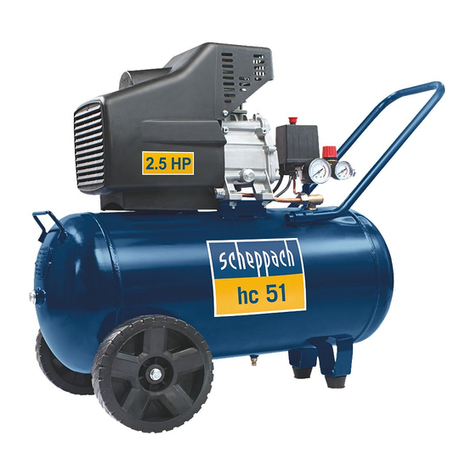
Scheppach
Scheppach HC51 Translation from the original instruction manual

ALDI
ALDI WorkZone WZK 183 user manual

Koci Elektromaschinen
Koci Elektromaschinen KC 100 Operating instruction

WilTec
WilTec AF189A Operation manual
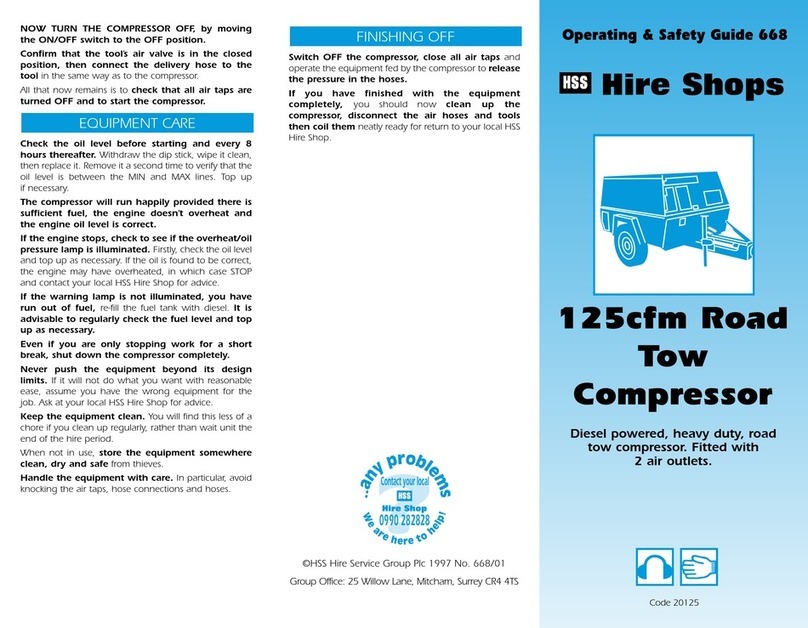
HSS Hire
HSS Hire 20125 Operating & safety guide
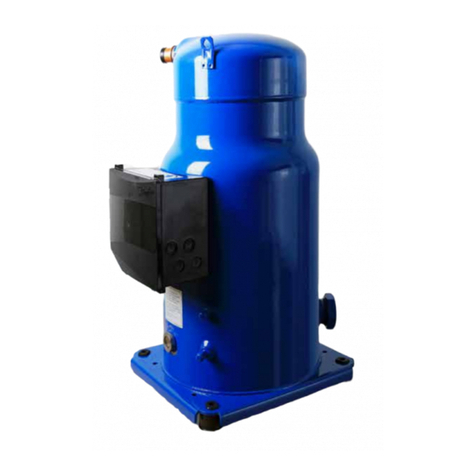
Danfoss
Danfoss MLM116 Application guidelines
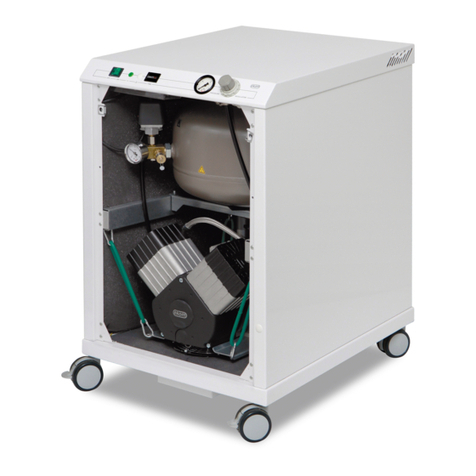
EKOM
EKOM DK50 2V MOBILE MINI user manual

Ingersoll-Rand
Ingersoll-Rand HP375WJD Operating, Maintenance & Parts Manual
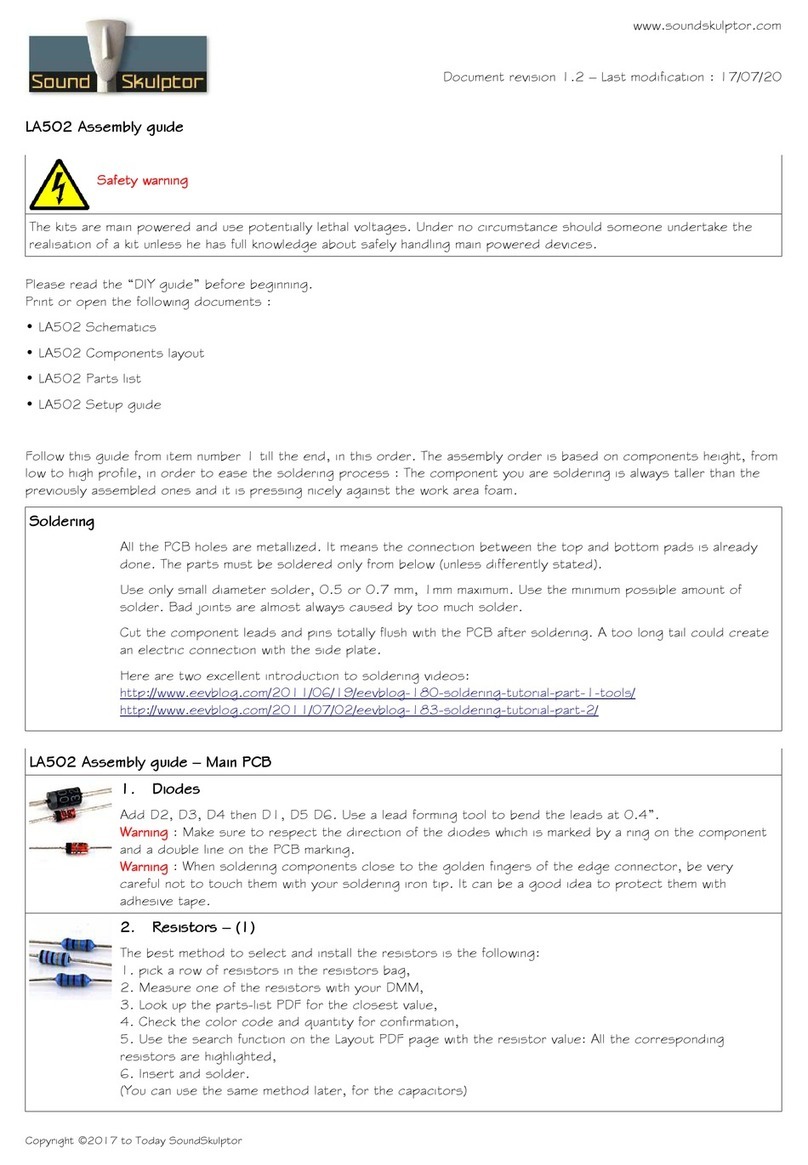
Sound Skulptor
Sound Skulptor LA502 Assembly guide
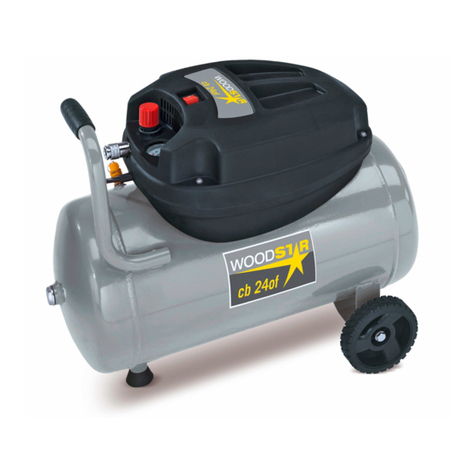
Woodstar
Woodstar cb 24of instruction manual

Scheppach
Scheppach HC25Si manual

Central Pneumatic
Central Pneumatic 38898 Assembly and operating instructions
